Alkaline phosphatase (ALP)
Alkaline phosphatase (ALP)
Sample for Alkaline phosphatase level (ALP)
- It is done on the Serum of the patient.
- A fasting sample is a better choice. It is advised to fast for 10 to 12 hours before taking the sample.
- This test can be done on a random sample as well.
- Getting good serum: Take 3 to 5 ml of blood in a disposable syringe or a vacutainer. Keep the syringe for 15 to 30 minutes at 37 C and then centrifuge for 2 to 4 minutes to get the clear serum.
- Keep the sample refrigerated as soon as you separate the serum.
- Because at room temperature level increases (up to 30% increase).
- The refrigerated sample also increases, which is slow compared to the room temperature sample.
- Testing should be done on the same day.
- Serum at 0 to 4 °C is stable for 2 to 3 days, and at -25 °C is for one month.
- Perform the test as soon as possible because ALP activity increases 3 to 10% on standing at 25° C or 4 ° C for several hours.
Precautions for Alkaline phosphatase (ALP)
- Storage At room temperature increases the ALP activity.
- Avoid EDTA and oxalate anticoagulants or fluoride, which decreases Alkaline phosphatase activity.
- Reject the sample in oxalate and citrate.
- If serum is left at room temperature:
- Then there is a 1% increase in 6 hours.
- 3 to 6% in 1 to 4 days.
- Even though it may increase if refrigerated the serum, which is 2%/day, the increase is slow.
- This increase may be up to 30% if the serum is left at room temperature or kept in the fridge.
- Recent intake of food may increase the value.
- Values may be 25% higher after taking the high-fat meal.
- Drugs that increase the level:
- Drugs like allopurinol, antibiotics, colchicine, indomethacin, fluorides, isoniazid (INH), methotrexate, nicotinic acid, methyldopa, phenothiazine, vitamin D, and probenecid can increase the alkaline phosphatase level.
- It increases after a fatty meal.
- Drugs that decrease the level:
- Drugs like fluorides, arsenal, cyanides, nitrofurantoin, and zinc salts may decrease the alkaline phosphatase level.
- Hemolysis may cause a slight increase in the ALP. ALP is 6 times more in the RBC than in the serum.
- Young children experiencing rapid growth, pregnant women, and post-menopausal females have a physiologically high alkaline phosphatase level.
- After I/V infusion of albumin, there may be a sometimes marked increase in alkaline phosphatase.
Indications for Alkaline phosphatase (ALP)
- Alkaline phosphatase is estimated to detect diseases of the liver and bone.
- Alkaline phosphatase is the best marker for obstructive jaundice.
- ALP distinguishes obstructive and hepatocellular jaundice.
- Alkaline phosphatase is the marker:
- For hepatic metastasis.
- In parathyroid diseases.
- Vitamin D deficiency.
- Acute pain in the abdomen.
Definition of Alkaline phosphatase (ALP):
- The body contains many phosphatases. These are classified based on pH at which they will show maximum activity.
- ALP shows maximum activity between pH of 9 to 10.
- Intestinal mucosa shows the greatest activity, followed by kidney, bone, thyroid, and liver.
- Regan isoenzymes are observed in 5% of cases with carcinoma. It is identical to the placental ALP isoenzyme.
- The bone, bile ducts, intestine, and placenta produce alkaline phosphatase.
Distribution of the alkaline phosphatase (ALP):
- This enzyme is present in the blood, and its subtypes are present in the liver, intestine, bones, and placenta.
- The maximum amount is present in the liver and biliary tree epithelium.
- The liver and the bone are two tissues for raised alkaline phosphatase levels.
- ALP is found in many tissues, at or in the cell membrane.
- ALP is a nonspecific enzyme capable of reacting with many different substrates.
- Liver and bone ALP are predominantly more in the serum.
- Due to bone activity, the alkaline phosphatase level is 1.5 to 2.0 times more in children than in adults.
- A small amount of the ALP from the intestinal epithelium is found in the sera of blood group B or O, which are secretors of blood group substances.
- The highest concentration is found in the liver. Within the liver, ALP is present in the Kupffer cells, which line the biliary collecting system. From there, this enzyme is excreted in the bile. Its concentration in the liver is low as compared to the biliary tree.
- ALP is mainly from the liver, and biliary tree, nearly up to 50% of the skeleton (osteoblastic cells), found in the intestinal epithelium, renal tubule cells, and lower concentration leucocytes and placenta.
- This ALP is age-dependent.
- Pregnancy can also lead to a raised level.
- Alkaline phosphatase in urine is from the renal tubule, not the plasma.
- This may be seen in renal lesions as a malignant tumor (carcinoma), nephrosis, nephritis, infarction, and systemic lupus erythematosus.
Effect of temperature on Alkaline phosphatase (ALP):
- ALP (serum) is denatured at 56 °C and stable at lower temperatures.
- The liver isoenzyme is moderately heat stable at 55° C, but the bone isoenzyme is heat-labile.
- Placental isoenzyme is stable at 65 °C but not others.
- Placenta ALP = Heat stable at 65 °C.
- Liver ALP = Moderately stable at 55 °C
- Bone ALP = Heat labile.
- Alkaline phosphatase level (ALP) is distinguished by heating. The common method is heat fractionation, where serum is heated at 56 °C for 15 minutes and finds the remaining ALP activity:
- Bone ALP activity will be only 10% to 20% of the original activity.
- The liver will retain ALP activity 30% to 50% of the original activity.
- Placenta ALP is heat stable and will contain virtually all of its activity.
- When serum is kept at room temperature will show increased activity.
- This varies from:
- 1% when kept for >6 hours.
- 3% to 6% >1 to 4 days.
- It will still increase slowly to 2% per day when kept in the fridge.
- When frozen, then the activity decreases, which will recover slowly after thawing.
- In lyophilized sera used for control as a reference also shows increased activity:
- 50% to 100% in 24 hours period.
- 10% when stored at 4 °C.
- 30% when stored at 20 °C.
- Alkaline phosphatase level (ALP) enzymes require Magnesium for the reaction.
- Post-puberty ALP is mainly from the liver.
- The conditions which will stimulate bone cells lead to an increase in the level of ALP.
Effects of Obstruction on Alkaline Phosphatase (ALP):
- The liver ALP is increased in biliary obstruction when its excretion is impaired. While in intrahepatic obstruction, there is less increase in ALP level than in biliary obstruction, which may go up to 2.5 times.
- Extrahepatic obstruction may reach 10 to 12 times the upper limit and is normal when a surgical obstruction is removed.
- In the case of infectious hepatitis, there may be moderate elevation or even normal.
Effect of bone activity of alkaline phosphatase (ALP):
- The stimulus which increases bone activity causes an increase in the ALP level. So elevated levels indicate liver or bone diseases.
- Bone alkaline phosphatase is produced by the osteoblast of the bone and not by the osteoclasts.
- ALP level rises during active bone formation, like in infants, children, and adolescents. So they have raised the level to 3 times the norm than the adults.
- Bone alkaline phosphatase indicates bone-forming activity.
The activator of the Alkaline phosphatase (ALP) enzyme are:
- Magnesium, Cobalt, and manganese.
- The exact ratio of Mg²/Zn² is important to avoid the displacement of the Mg² to get optimal activity.
- Zinc is a constituent metal ion.
Inhibitors of the Alkaline phosphatase (ALP) enzyme are:
- Alkaline phosphatase level (ALP) inhibitors are:
- Borate
- Phosphate.
- Cyanide
- Oxalate.
Alkaline Phosphatase (ALP) Isoenzymes are:
- The ALP is divided into isoenzymes based on the following:
- Acrylamide gel Electrophoresis.
- Characteristic inactivation by heating.
- Incubation and inhibition by the urea.
- Inhibition by the L-phenylalanine.
| Isoenzyme of ALP | Effect of heat/urea | Effect of L-phenylalanine | Electrophoresis (anodal mobility) |
| Bone | Positive (+++) | Negative | 2 (++) |
| Liver and biliary (ALP1) | Positive (+) | Negative | 1 |
| Intestinal | Positive (+) | Positive (+++) | 4 (++++) |
| Placenta | Negative | Positive (+++) | 3 (+++) |
| Regan (Oncofetal placental ALP) | Negative | Positive (+++) | 3 (+++) |
Liver Alkaline phosphatase (ALP) isoenzyme (ALP1):
- Alkaline phosphatase (ALP) is formed by the liver cells and biliary tract epithelial cells.
- This is derived from the epithelial cells of the biliary tract.
- Alkaline phosphatase (ALP) increases in:
- Active liver disease.
- Biliary tract obstruction, whether intrahepatic or extrahepatic.
- Whether mild or severe disease.
- Whether a localized disease or extensive involvement of the liver.
- 50% of the liver and biliary ALP is inactivated by heat.
- The normal route of elimination is the excretion of bile into the intestine.
- This fraction moves fastest on electrophoresis, followed by bone, placenta, and intestinal fraction.
- This is moderately heat-stable.
- Alkaline phosphatase (ALP) will be raised in:
- Extrahepatic common bile duct obstruction.
- Biliary tract obstruction.
- Biliary tract obstruction due to liver cell injury.
- Liver space- occupying lesions like tumors, granulomas, and abscesses.
- Uncommon conditions are primary biliary cirrhosis.
- Alkaline phosphatase (ALP) raised level is seen in:
- 5% of patients with viral hepatitis.
- 5% of the patients with active alcoholic cirrhosis.
- 13% to 20% of the patients with infectious mononucleosis.
- 75% to 80% of the metastatic tumors of the liver.
- 100% of the cases show in biliary tract obstruction, except in partial or intermittent obstruction.
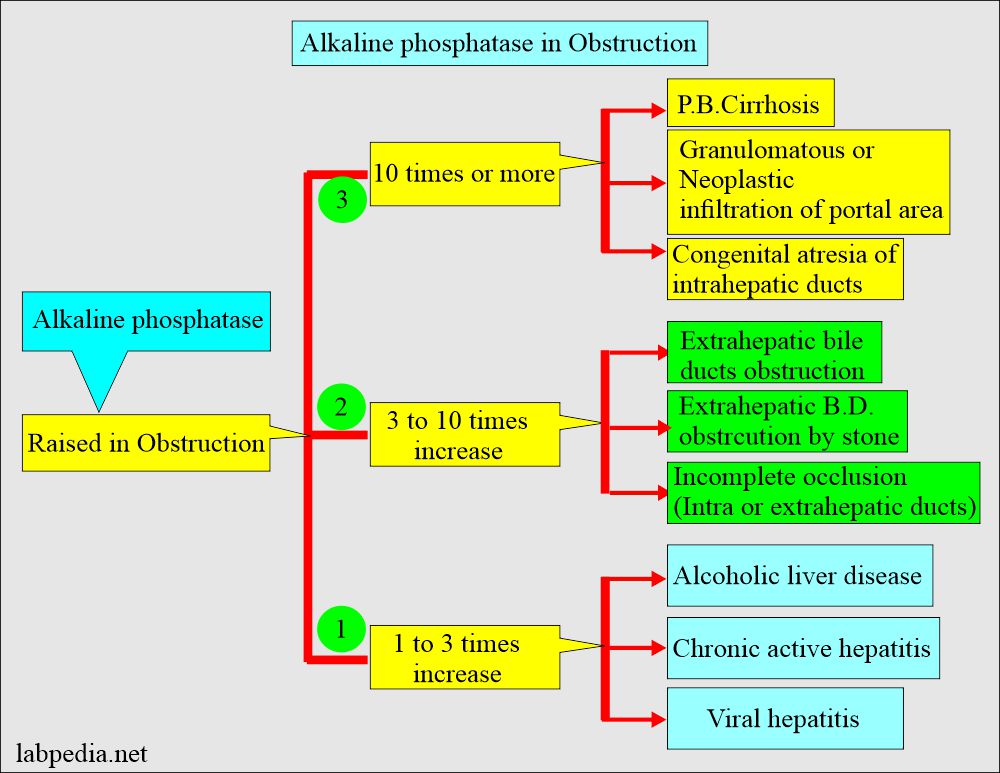
Alkaline phosphatase (ALP) level in obstruction
Bone Alkaline phosphatase (ALP) isoenzyme (ALP2):
- Bone is the second most common cause of raised Alkaline phosphatase (ALP).
- Osteoblast produces a large amount of Alkaline phosphatase (ALP).
- The heat inactivates 90% of the bone isoenzymes.
- This increases due to osteoblastic activity and is normally elevated in children and older people above 50 years of age.
- Alkaline phosphatase (ALP) raised level is seen in:
- Children at growing age will have high-level ALP.
- Adults with healing fractures of the bone have raised levels of ALP.
- Paget’s disease leads to a very high level, 10 times or more upper limits of the normal.
- ALP is raised in metastasis to the bone, myeloma, and metabolic bone diseases like rickets, hyperparathyroidism, and osteomalacia.
- Deficient levels of this bone ALP are seen in the metabolic disorder of hypophosphatasia.
- To differentiate the origin of Alkaline phosphatase (ALP), whether from bone or liver diseases, advice:
- Gamma-glutamyl transferase (GGT). Mostly GGT is not raised in bone diseases.
- 5-nucleotidase.
- Serum electrophoresis is difficult but more reliable.
Intestinal Alkaline phosphatase (ALP) isoenzyme (ALP):
- It is ∼25% of the normal sera.
- This depends upon the blood group and the secretor status of people.
- Blood group B or O and secretor are more likely to have this isoenzyme. In this group, it will increase ALP after 2 hours of the meal.
- This will lead to false positives in nonfasting individuals, particularly Lewis positive type B and O secretors.
- After the ingestion of the meals will increase the ALP by 30% for 2 to 12 hours.
- A fasting ALP level is indicated.
- This is inactivated by heat.
- This will be raised in inflammatory bowel diseases like ulcerative colitis and regional enteritis.
- This isoenzyme may lead to abnormal values in a non-fasting sample.
Placental Alkaline phosphatase (ALP):
- Alkaline phosphatase (ALP) placental origin starts to rise by the end of the first trimester and reaches a peak (up to 4 times the normal) by the third trimester.
- The rise in the second and third trimesters will be both placental and bone origin.
- 60% is the placental origin.
- Placental ALP appears 16th to 20th week of gestation. Then it keeps on increasing, two times the normal at the time of labor.
- It disappears 3 to 6 days after the delivery.
- Bone derived
- Placental ALP appears 16th to 20th week of gestation. Then it keeps on increasing, two times the normal at the time of labor.
- It disappears 3 to 6 days after the delivery.
- Bone-derived alkaline phosphatase persists longer and may be seen more than 6 weeks of the infant.
- Placental ALP is not inactivated by heat. It tolerates moderately high temperatures without decomposition and loss of activity.
- This is usually seen in a pregnant mother’s blood, which is placental in origin.
- This may increase pregnancy complications, like hypertension, preeclampsia, and threatened abortion.
- It is lower in diabetic than in non-diabetic pregnancies.
- This oncofetal form of placental ALP is also referred to as Regan isoenzyme after the patient in whom it was first-time described.
Renal Alkaline phosphatase (ALP):
- Renal tubular cells have ALP activity that is normally excreted in the urine.
- It does not reach the serum in pathological conditions.
- The sloughed renal cells may cause an artificial false-positive result on the new immunoassay screening procedure.
Granulocytes Alkaline phosphatase (ALP):
- ALP in the granulocytes does not raise the serum ALP level.
- This is helpful as a marker for granulocytic maturity in leucocytosis.
Alkaline phosphatase isoenzymes classification and differentiation:
| Basis for classification | Isoenzyme liver | Isoenzyme intestine | Isoenzyme bone | Isoenzyme placenta | Isoenzyme Renal |
| Amount of ALP |
Present in the serum | Present in the serum in inflammatory GI tract diseases | Present in the serum | Trace amount found in serum | Excreted in urine |
| Heat stability | Stable at 56 °C for 30 minutes, more than bone | Disappear at 56 °C within 15 minutes | Disappear at 56 °C within 10 minutes | Stable at 65 °C for 30 minutes (Regan 15 to 15% cases of cancers) | |
| Chemical inhibition | By urea but low by L-phenylalanine | Strong by L-phenylalanine | Strong by urea but low by L-phenylalanine | Resistance to urea but strong inhibition by L-phenylalanine | |
| Electrophoresis | Most anodic | Cathodic to the bone fraction | Intermediate | Migrate with the placenta or bone fraction | Renal isoenzyme is more cathodic and slower |
| Gene arrangement | Similar to the liver, the short arm of chromosome 1 | Product of unique gene long arm of chromosome 2 | Similar to the liver, the short arm of chromosome 1 | Different Chromosome 2 | Similar to the liver, the short arm of chromosome 1 |
The alkaline phosphatase (ALP) functions:
- The exact metabolic function of ALP is still not known.
- The main function is to remove the phosphate group from the proteins and other molecules.
- These are necessary for the hydrolysis of organic phosphate and are important for digestion and mucosal absorption.
- ALP is associated with lipid transport in the intestine.
- The second role is in the osteoblastic tissues. The metabolic activity of the osteoblasts is associated with ALP activity.
- ALP is also associated with the calcification process of the bone.
- ALP is beneficial in distinguishing various bone diseases and hyperparathyroidism when combined with serum calcium and X-rays.
- Alkaline phosphatase is called Alkaline because its function is seen between a pH of 9 to 10 and best at a pH of 9.0.
Normal Alkaline phosphatase (ALP)
- Value varies according to the kit and methodology used.
- As Alkaline phosphatase level (ALP) exists in various tissue, isoenzymes may be advised in the case of raised levels.
- It is suggested that at least 1,5 times increase the need for further workup of the patient if this value is found on 2 separate test results >6 months apart.
Source 6
| Adult Male | 25 to 100 U/L |
| Adult Female | 25 to 100 U/L |
| Children/adult | <2 years = 85 to 235 U/L |
| 2 to 8 years = 65 to 210 U/L | |
| 9 to 15 years = 60 to 300 U/L | |
| 16 to 21 years = 30 to 200 U/L |
Source 4
Male
- 1 to 12 years = <350 U/L
- 12 to 14 years = <500 U/L
- >20 years = 25 to 100 U/L
Female
- 1 to 12 years = <350 U/L
- >15 years = 25 to 100 U/L
- ALP is slightly higher in the male than the female. It rises in females after middle age.
- There will be a biliary disease if = ALP raised + 5′-nucleotidase raised.
- If ALP raised + 5′-nucleotidase is normal, then think about other causes.
The principle of Alkaline phosphatase (ALP) chemical reaction:
- Alkaline phosphatase is an enzyme of the hydrolase class that catalyzes orthophosphate cleavage from orthophosphoric monoesters under alkaline conditions.
- There is colorless substrate p-Nitrophenyl phosphate (4-nitrophenyl phosphate), and by the action of ALP enzyme converted to p-Nitrophenol (4-nitro phenoxide, benzenoid form) is colorless, changed to 4-nitophenoxide, is the quinonoid form which is a yellow color in alkaline medium.
Alkaline phosphatase (ALP) in liver diseases differential diagnosis:
- In the absence of bone disease or pregnancy, markedly raised Alkaline phosphatase ( around 10 times ) is the best obstructive liver pathology marker, like gallstones obstructing the biliary tract.
- Also, advise 5′-nucleotidase, which will be raised in case of biliary disease. If it is normal, then search for other causes of raised ALP.
- 1 to 2 times raised levels may be seen in various liver parenchymal diseases like Hepatitis and Cirrhosis.
- In extrahepatic obstruction due to stones and cancer, ALP increases 3 times the normal.
- In the case of complete obstruction, ALP may be raised 10 to 12 times.
- In the case of intrahepatic obstruction, ALP rises but less than extrahepatic obstruction.
- In the case of infectious diseases, ALP rises but <3 Times.
- In pregnancy, the average increase in ALP is 1.5 times the normal limit between 16 to 20 weeks, and it persists till labor.
- After labor, ALP comes to normal within 3 to 6 days.
- This may be raised in pregnancy complications like hypertension, Eclampsia, pre-eclampsia, and threatened abortion.
- To confirm the hepatobiliary origin of ALP, advise γ-GT or 5-nucleotidase.
- ALP is a sensitive marker for hepatic metastasis. If there is hepatomegaly without jaundice indicates metastatic liver disease.
Alkaline phosphatase level (ALP) may be mildly raised in:
- Metastatic diseases of the liver.
- Hepatocellular carcinoma.
- Biliary Cirrhosis.
- Intrahepatic and extrahepatic cholestasis.
- Gilbert’s syndrome.
- Chronic alcohol ingestion.
- Diabetes mellitus and diabetic hepatic lipidosis.
Alkaline phosphatase (ALP) in bone diseases:
- It is increased in bone diseases like Paget’s disease, healing fractures, Rickets, pregnancy, and childhood.
- Metastatic bone tumors.
- Osteogenic sarcoma.
- Osteomalacia ( while in osteoporosis, ALP is normal ).
- There is a higher level of ALP in children and infants, and it is 3 times the adult level.
Alkaline phosphatase in bone diseases:
Disease |
ALP increased |
Explanation |
| Paget’s disease | 10 to 25 times | Osteoblastic activity increases the ALP |
| Osteomalacia | Moderate increase | Level lowers with treatment |
| Rickets disease | 2 to 4 times | Level lowers with treatment |
| Osteoporosis | Normal level | |
| Physiologic bone growth | Increased level | |
| Healing fracture | mild, transient raised level | |
| Fanconi’s syndrome | Mild to moderate increase | |
| Primary and secondary hyperparathyroidism | Mild to moderate increase | |
| Osteogenic sarcoma | Very high level | |
| Pregnancy third trimester | 2 to 3-time increase | This is the placental origin. |
| Children | 1.5 to 2.5-times increase | Growing age |
| Metastatic tumor-like Ca prostate | Raised level | |
| Solitary bone cyst | Normal |
Other causes for raised alkaline phosphatase (ALP):
- It is also raised in old age and pregnancy.
- Hodgkin’s disease.
- Sarcoidosis.
- Amyloidosis.
- Pulmonary and myocardial infarction.
- Hyperthyroidism (with a raised level of calcium).
- Chronic renal failure.
- Ulcerative colitis.
- ALP is increased during the last trimester of pregnancy and falls to normal within 3 to 6 days (postpartum).
- Hyperparathyroidism.
The alkaline phosphatase level (ALP) decrease is seen in:
- Malnutrition.
- Hypothyroidism (Cretinism).
- Milk-alkali syndrome.
- Celiac sprue.
- Scurvy (vit. C deficiency).
- Gross anemia.
- Deposition of radioactive material in the bone.
- In hypophosphatemia.
- Pernicious anemia.
- Nutritional deficiency of zinc or magnesium.
- Theophylline therapy.
- Estrogen therapy in postmenopausal females.
- Wilson’s disease.
Alkaline phosphatase raised level in various conditions:
| Level of raised Alkaline phosphatase (ALP) | Causes of raised Alkaline phosphatase (ALP) |
|
|
|
|
|
|
Questions and answers:
Question 1: When Alkaline phosphatase level (ALP) is raised in bone diseases?
Question 2: What is the significance of Alkaline phosphatase level (ALP)?


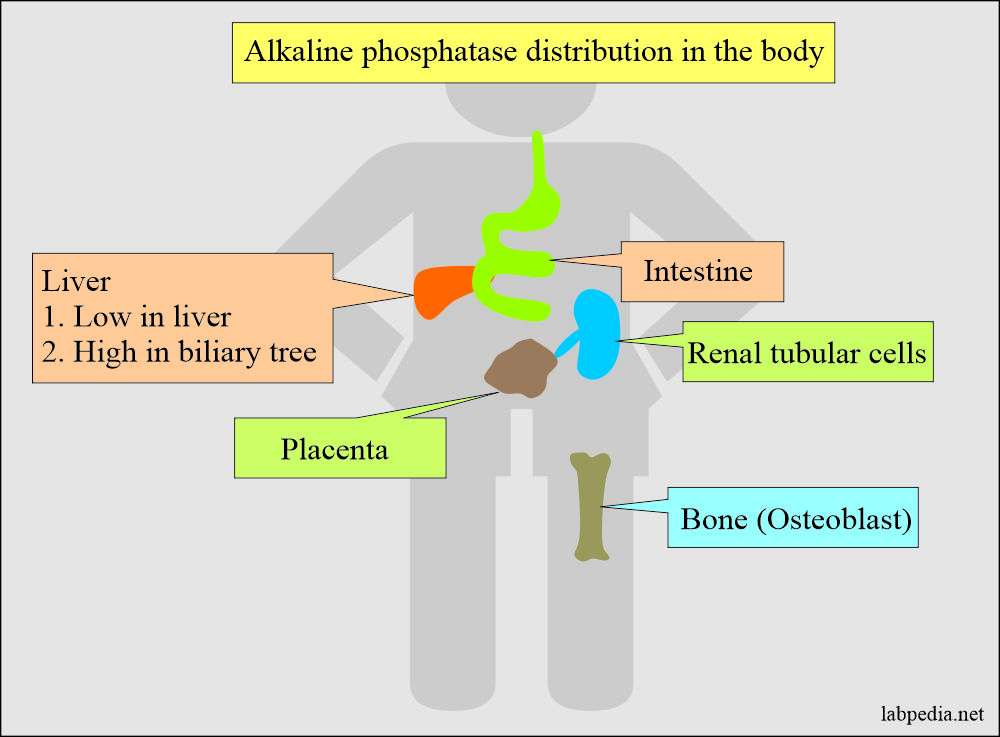
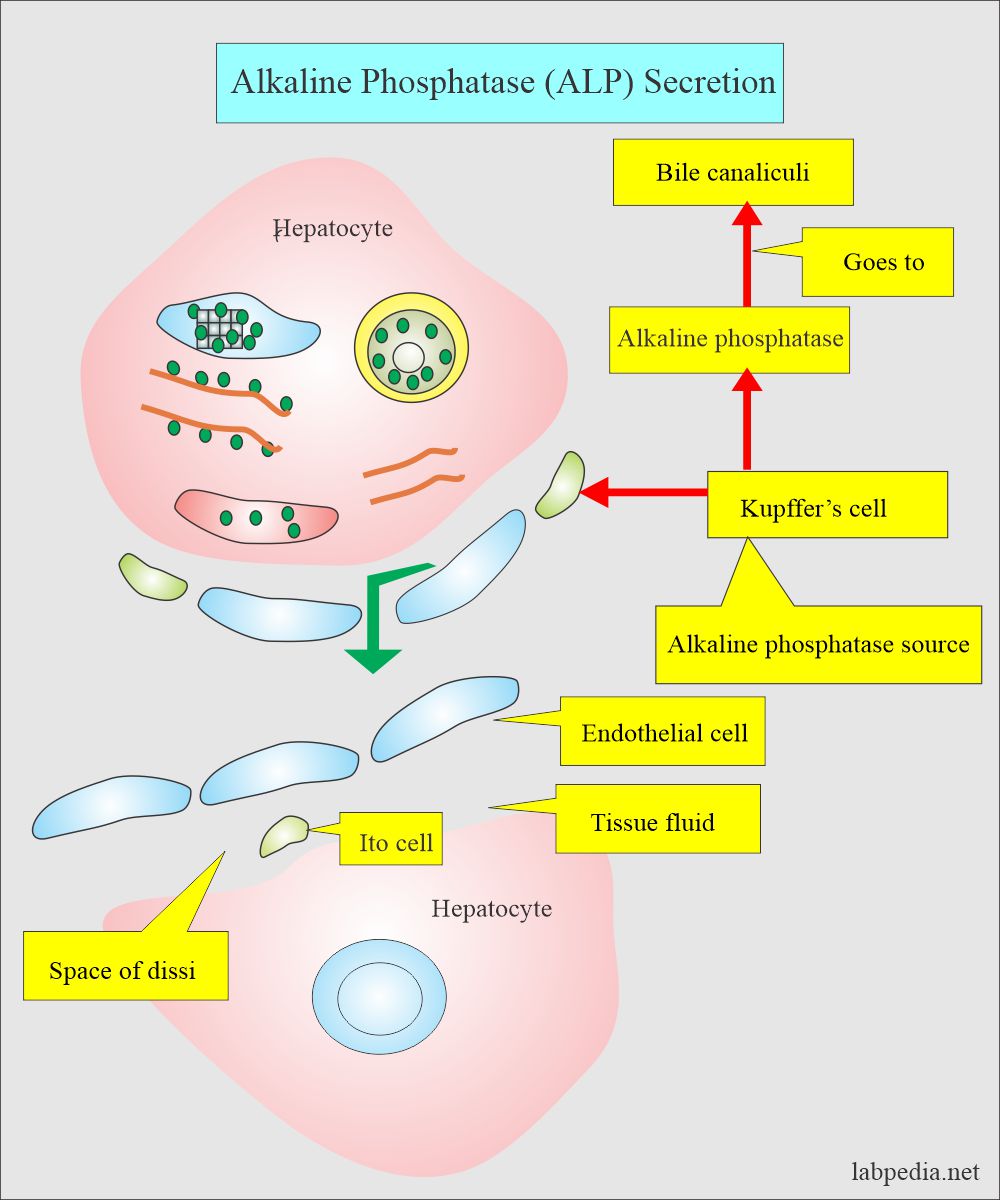
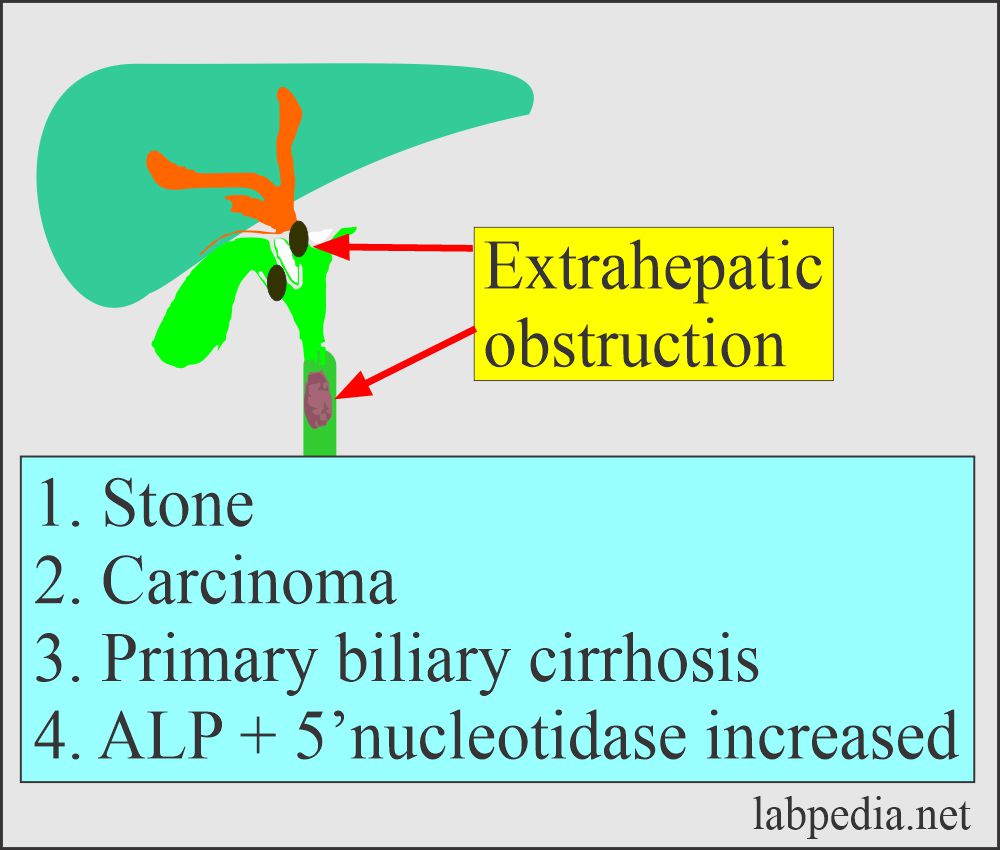
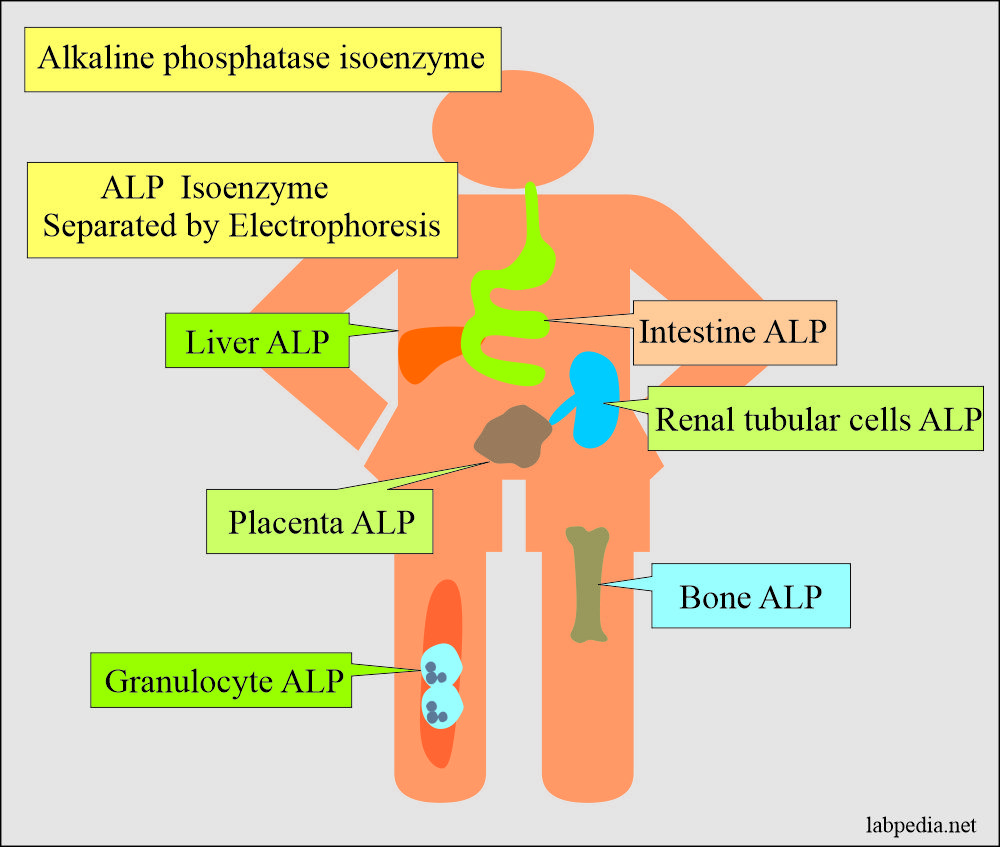
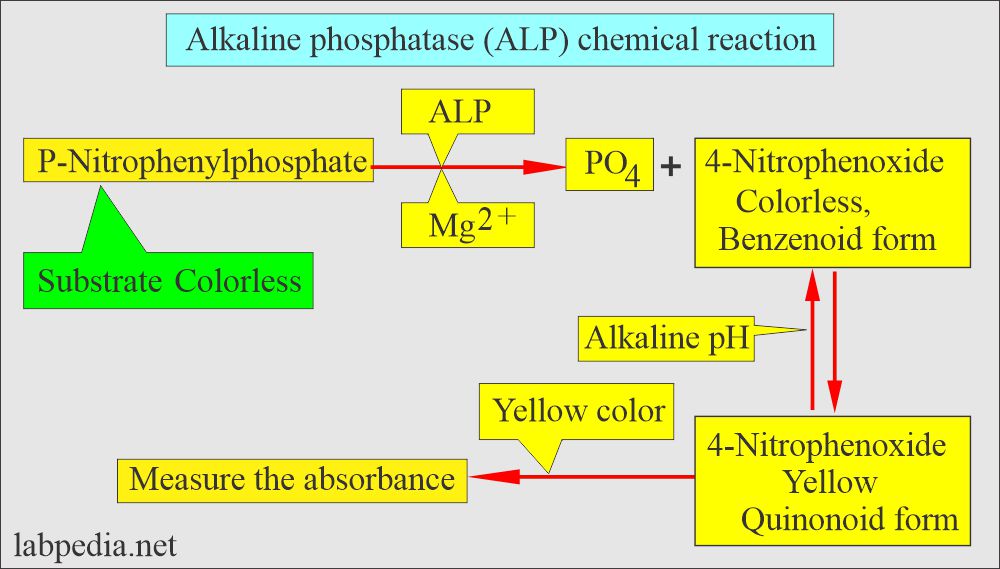
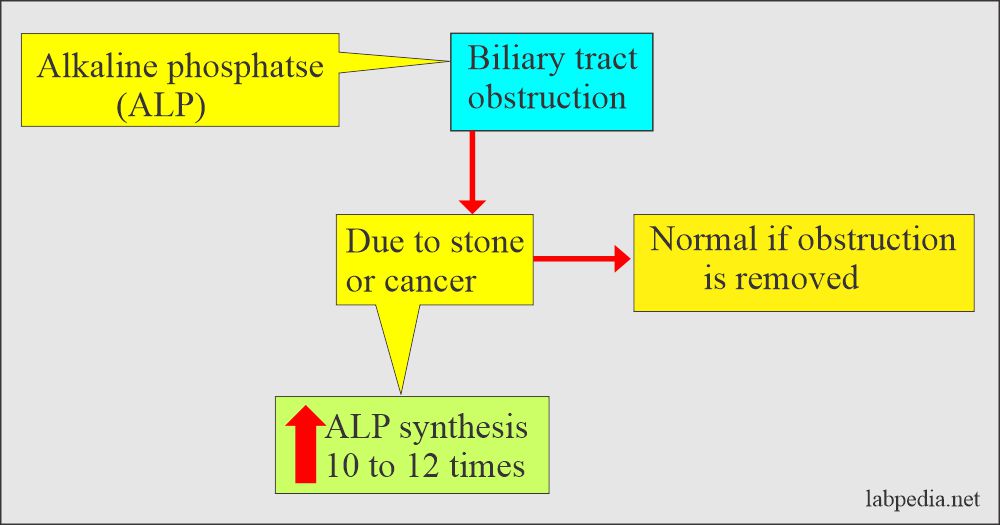
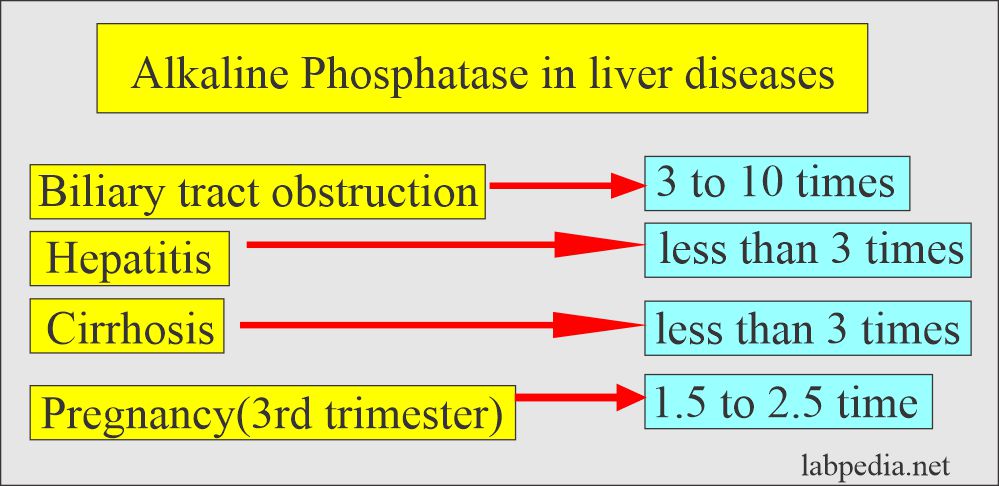
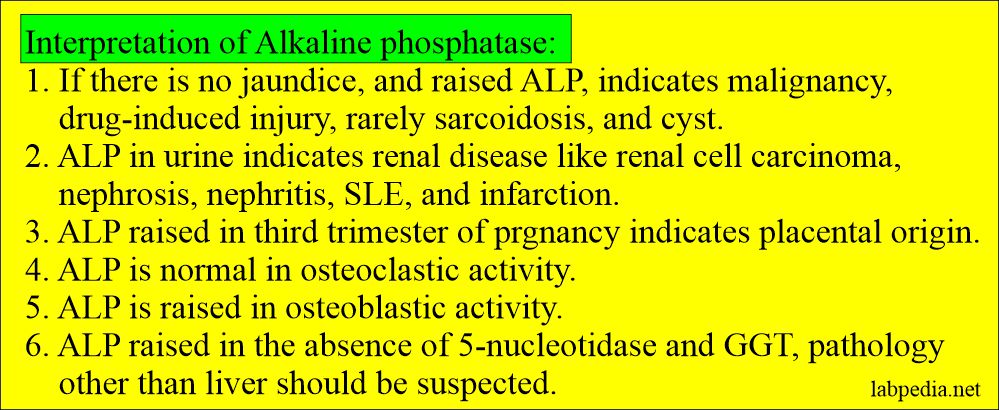
very helpful information.concise and compact.
Thanks for the encouraging remarks
nice and comprehensive information, thanks a lot.
Thanks.
Very well written article on ALKALINE PHOSPHATASE
Thankyou Dr Riaz and team
Thanks for your appreciation.
token of thanks sir
Thanks.
THANKS